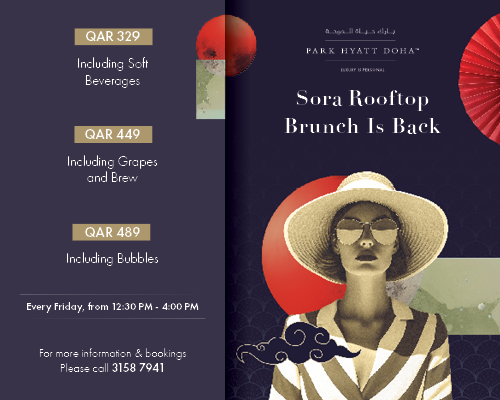The highly anticipated Desert Rose Symphony, featuring Syrian-American composer Malek Jandali, premiered to the world at the National Museum of Qatar (NMoQ) this week.
The performance marked the ten-year anniversary of the Years of Culture initiative, a platform for exchange and collaboration connecting cultures and continents through annual bilateral exchanges.
 The symphony and anniversary celebrations were attended by HE Sheikha Al Mayassa bint Hamad bin Khalifa Al Thani and the different ambassadors of the many countries that previously partnered with the Years of Culture since it started in 2012. These include Japan (2012), the United Kingdom (2013), Brazil (2014), Türkiye (2015), China (2016), Germany (2017), Russia (2018), India (2019), France (2020), USA (2021)، and the MENASA region this year.
The symphony and anniversary celebrations were attended by HE Sheikha Al Mayassa bint Hamad bin Khalifa Al Thani and the different ambassadors of the many countries that previously partnered with the Years of Culture since it started in 2012. These include Japan (2012), the United Kingdom (2013), Brazil (2014), Türkiye (2015), China (2016), Germany (2017), Russia (2018), India (2019), France (2020), USA (2021)، and the MENASA region this year.
According to Qatar Museums Chairperson, HE Sheikha Al Mayassa, when Qatar won the rights to host the FIFA World Cup™, they mapped out a Years of Culture plan to bring the world to Qatar and Qatar to the world. Since then, Qatar has partnered with another nation each year for a far-reaching programme of bilateral cultural exchange. Strengthening relationships with partner nations and fostering mutual understanding between the people of the two countries, the Years of Culture helped show the best of Qatar, carrying the country towards the goals of the Qatar National Vision.
This year, we are at last welcoming everyone to the World Cup and celebrating a Year of Culture with all the nations of the MENASA region. I am truly thankful for their support and grateful to the ambassadors and officials who have joined together to realise our vision.
The Desert Rose Symphony
The Desert Rose Symphony was performed by the Qatar Philharmonic Orchestra with Grammy-nominated guest conductor Alastair Willis. Fans can listen to the symphony for free on AppleMusic and Spotify. Copies of the album are also available at all Qatar Museums gift shops.
Director of Cultural Diplomacy Aisha Al Attiya said that the Years of Culture initiative is based on the idea that beautiful things happen when cultures connect. She said that Jandali was able to weave a beautiful musical tapestry with authentic Middle Eastern melodies that honour and preserve Syrian heritage and now the heritage of Qatar.
We are honoured by the support of all our international partners and eager to grow this powerful group for years to come, starting with Indonesia as our official Years of Culture partner country for 2023.
Jandali, meanwhile, said that through this timely partnership with Years of Culture, he has the honour of presenting Qatar’s musical traditions on the global stage.
Together, we are contributing our rich Arab heritage to the lexicon of classical music and the progression of cultural modernity. We welcome orchestras around the world to join our symphony of peace, unity and humanity.
For his support and contribution to the preservation of cultural heritage, Jandali was named as Qatar Museums’ new honorary Composer-in-Residence. The symphony is the culmination of more than four years of research and exploration, during which Jandali entrenched himself in the sounds and landscapes of Qatar, to preserve and present Qatari cultural heritage and traditions on the global stage.
Inspired by nature
The Desert Rose is inspired by nature’s desert rose, which forms over millennia through the interaction of minerals, sand and water in regions such as Qatar – a land of desert and sea. This wonder of nature is also the basis for Jean Nouvel’s spectacular design of NMoQ, a stunning structure of interlocking discs that tells the story of Qatar from the natural history of its origins through its cultural developments to the cutting-edge technologies and international allure of today.
The Desert Rose Symphony takes its inspiration from both desert roses, transforming them into a consummate orchestral work that preserves and extends the rich heritage of the region. The symphony is also a reference to the flag of Qatar, with its nine movements – each based on an iconic element of Qatari culture – evoking the nine-point serrated line on the flag.
Interlaced musical form
Like its inspirations, the Desert Rose symphony harbours an elaborate interlocking structure.
Bookmarked in A-flat major, in which key the first and last movements end, the symphony comprises three interlaced musical forms. One is a Qatari symphonic suite based on traditional folk music and dances using the principle of contrast: Movements II, III, V and VII. The second is a traditional old-fashioned symphony of four movements I, IV, VI and IX. The third combines the first two symphonies with Movement VIII, which brings about the grandiose conclusion of the Desert Rose.

Listen to the Desert Rose symphony here.
Check out Marhaba’s FREE e-Guides for everything you need to know about Qatar.





